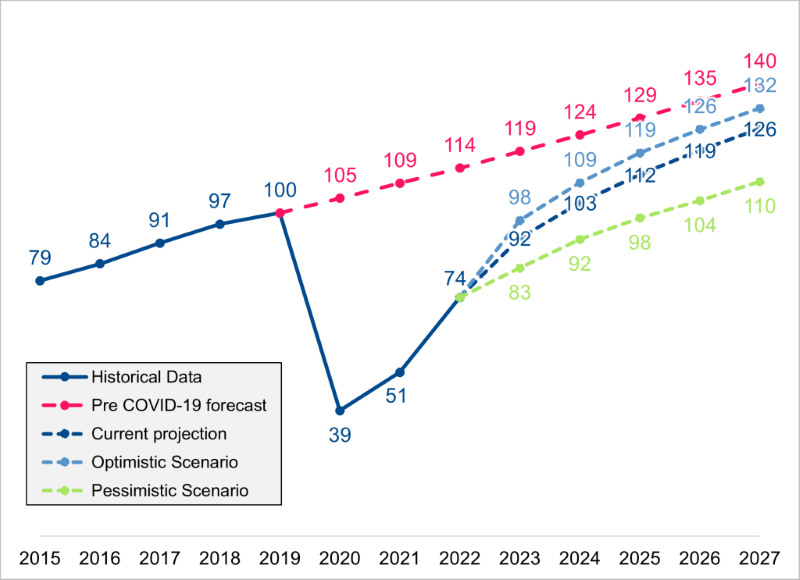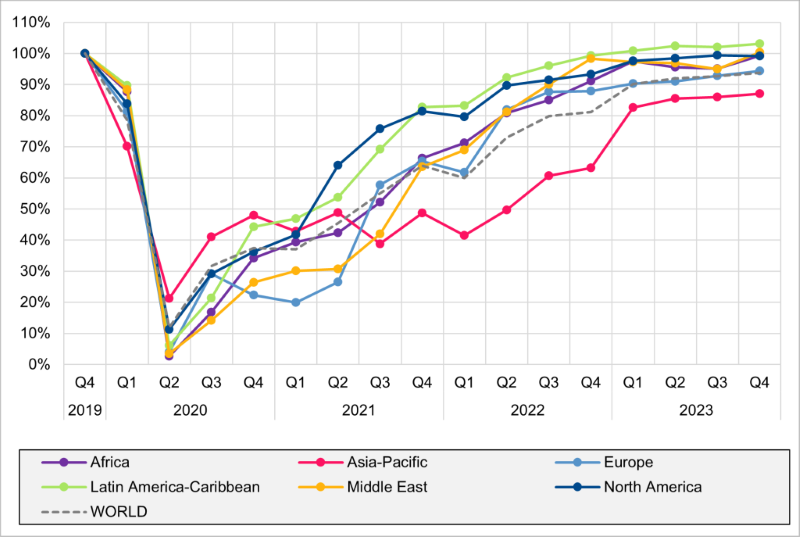INTERNATIONAL. New Airports Council International (ACI) World data suggests that global passenger traffic in 2023 will reach 8.4 billion, hitting 92% of 2019 levels.
In its latest quarterly airport traffic outlook published today, the airports association predicts a continued strong traffic trend seen in the first quarter of 2023, mainly driven by the reopening of China’s economy and the decline in global energy and food prices.
ACI World Director General Luis Felipe de Oliveira said: “Increasing passenger volumes, rising consumer confidence in most OECD countries, combined with declining jet fuel prices, suggests air travel demand will remain strong into the northern hemisphere summer season. The opening of Chinese aviation markets represents especially positive progress in global activity and air travel demand.”

By region, Asia Pacific is forecast to generate the strongest recovery, with 2.9 billion passengers, or 85.3% of the 2019 level. This is despite a slower recovery in 2022 compared to the global average.
The organisation expects a strong full-year performance in North America, with traffic reaching 2 billion passengers, 98.7% of the 2019 level.
In Africa, passenger volumes are expected to reach 222 million this year, or 96.8% of pre-pandemic traffic levels.

Having posted the highest passenger traffic increase in 2022, Europe will likely experience subdued growth this year, with 2.2 billion passengers, or 92.2% of the 2019 level.
The positive trend in the Latin America-Caribbean region is anticipated to continue in 2023. ACI World projects that the region will surpass 2019 volumes as it reaches 701 million passengers.
In the Middle East, passenger numbers are estimated to hit 396 million, or 97.3% of the 2019 level.

According to ACI World, airports are expected to welcome 2.7 billion passengers in Q2 and 2.9 billion in Q3.
It noted that the share represented by international passengers is expected to account for 38% of total traffic in 2023, nearing the 42% in 2019.
Economic uncertainties remain a concern
Despite the positive trends, inflationary pressures continue to impact the aviation industry, ACI World noted. The industry has been hit by cost pressures and tight labour markets resulting in potential challenges in maintaining profitability and managing expenses for airports, it added.
ACI World said: “Inflation is expected to gradually moderate over 2023 and 2024 but is likely to remain above central bank targets until the latter half of 2024 in most countries. This inflationary environment can further strain the financial viability of airports as they face increased operational costs.”
De Oliveira added: “We must be vigilant. GDP growth forecasts have moderated and energy and food prices, although decreased from their peak levels, remain higher than pre-pandemic levels. Inflation will also be an issue in the near term, straining the financial viability of airports as they face increased operational costs.
“Amid this background, regulators must support airports by allowing them to operate as businesses in their own right. In many jurisdictions, airports cannot adjust charges without regulatory approval – conversely, airlines can freely adapt their tariffs based on demand and supply factors.
“Flexible policies on charges can help airports recover and grow sustainably, optimise the use of infrastructure and the customer experience, invest in current and future infrastructure, meet decarbonisation targets, and maximise airports’ social and economic benefits among many other benefits.” ✈













